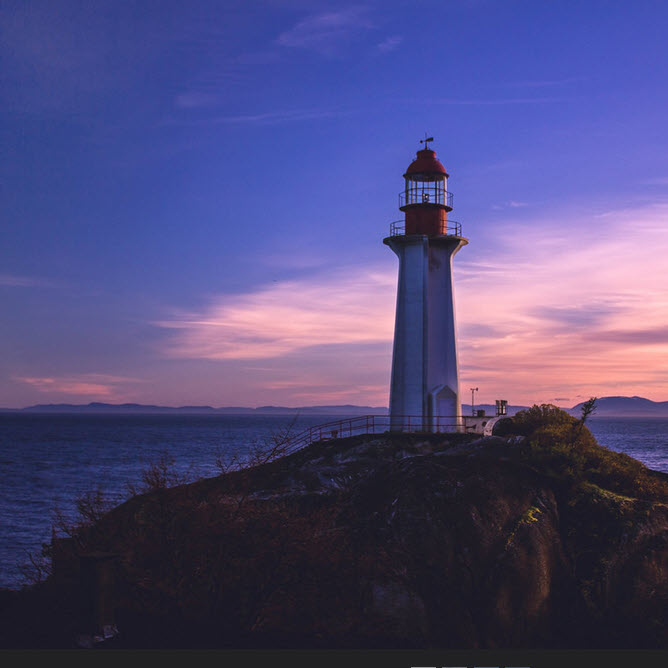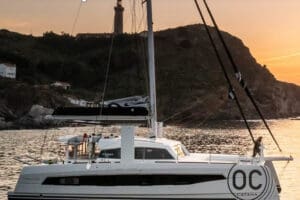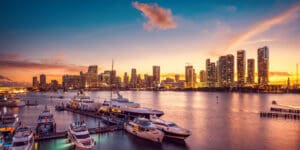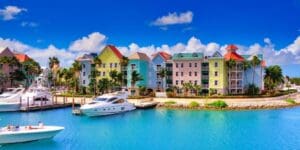Lighthouses hold the attention of sailors and landlubbers alike. There always seems to be an interesting story no matter the life-saving beacon’s location. Plus, the variety of lighthouse architecture…square, round, conical, rectangular, and even octagonal…along with colors give character to each. But even as intriguing as they are, we tend to take them for granted.
Here are some interesting facts about these amazing structures that have been around for millennia. It is amazing that with all the technology we sailors have today, that we still rely on these signals. Even by day, they make handy visual markers to guide you on your way.
1st Known Lighthouse
The first we know about was actually one of the Seven Wonders of the Ancient World, the Lighthouse of Alexandria, also known as the Pharos of Alexandria as it stood on the island of Pharos in the city’s harbor. The lighthouse was commissioned and begun during the the reign of first Ptolemy (Ptolemy I Soter). In 305 BC, after Alexander the Great died, he declared himself king and commissioned the lighthouse’s construction.
Finished during the reign of his son, Ptolemy II Philadelphus, it took 12 years and 800 talents of silver to complete. That was about 1/10 of the Treasury at the time and almost twice what it cost to build Rome’s Parthenon.
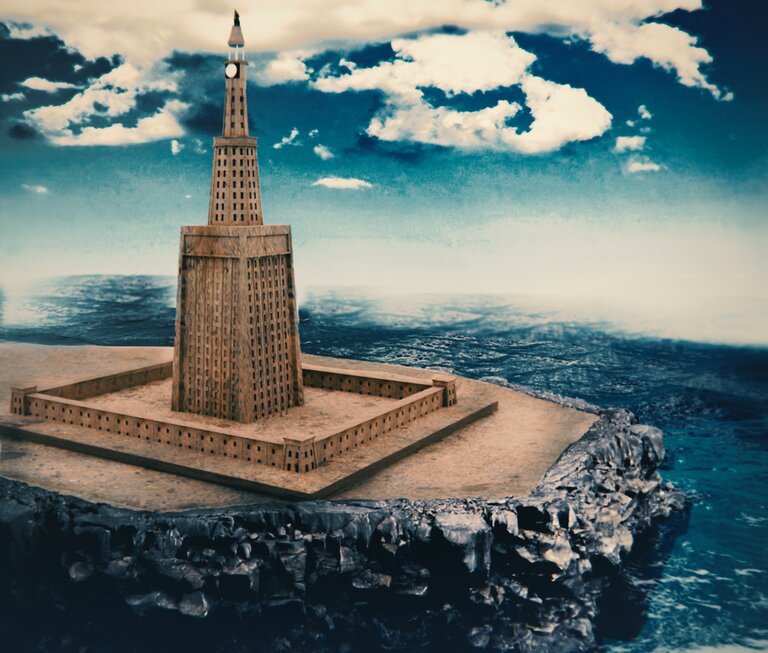
The tower was mostly with solid blocks of limestone and granite and the light was produced by a furnace at the top. At about 350 feet high, the monument was one of the tallest structures in the world. Frequent earthquakes eventually reduce it to rubble by the 14th century. But it lives on today as it served as an archetype from which all other lighthouses have arisen.
Oldest Surviving Lighthouse
In the 1st century AD, the Romans built the Farum Brigantium, known today as the Tower of Hercules and a UNESCO World Heritage Site. Astonishingly, the lighthouse remains in operation guiding sailors from it perch in northwestern Spain’s La Coruña harbor. An 18th-century restoration of the tower preserved the original structure core and improved its functionality.
The oldest existing (never rebuilt) lighthouse in the US is at Sandy Hook, NJ. The beacon built in 1764 is still in operation. Part of the construction budget for the lighthouse was paid for by the sale of lottery tickets and the other part by shipping interests in New York City.
The “tropic” lines are defined based on the sun’s geographical relationship to Earth. The Tropic of Cancer is the northernmost point where the sun is directly overhead at high noon during the northern hemisphere’s summer solstice in June. The Tropic of Cancer is where the sun is directly overhead during winter solstice in December. The Tropic lines are located 23.5° north and south of the equator.
U.S. Has Most Lighthouses of Any Country
The first lighthouse in the US was built in 1716 near Boston on Little Brewster Island. Lighthouses were vital to early America given its beginnings came from immigration by sea. So in 1789, the first U.S. Congress passed the Lighthouse Act creating the Lighthouse Establishment under the Department of the Treasury.
Today, our nation is home to 700+ lighthouses, more than any other country in the world.
You may be surprised to learn that the state with the most lighthouses is nowhere near the sea. In fact, it is Michigan that is surrounded by 4 of the 5 Great Lakes and home to 130 lighthouses, including the remote o on Stannard Rock, nicknamed “the loneliest place in North America.”
Not all Light-Signals are Attached to Land
In 1731, English inventor, Robert Hamblin, designed a lightship mooring it at the mouth of the Thames River on the Nore sandbank. The ship had a lighted beacon and just like its land-tethered cousins, was used to guide boats at night and in storms. Lightships were an ingenious solution for areas where building a lighthouse was impractical. In 1820, the US established its own lightship service and placed its first off Willoughby Spit in Chesapeake Bay, Virginia. The country’s last lightship, the Nantucket, retired in 1985 as automated buoys and other modern technology overtook their usefulness.
1819 Lighthouse Invention Still Exists
Early modern lighthouses were less effective than they needed to be because the most common lenses used until the early 1800s, known as Lewis lamps, were not powerful. In 1821, French inventor, Augustin-Jean Fresnel, introduced the Fresnel lens that used a series of prisms to focus all the light from a lamp in one unified direction magnifying it into a much more powerful beacon. Fresnel lenses replaced most lighthouse beams throughout the world. Effective and stunningly beautiful. The technique introduced by this lens is still used today in professional lighting equipment and floodlights.
First US Lighthouse to Use Electricity
In the 18th century, oil and gas lamps became the technology of choice over the use of furnaces for millennia. But as the 20th century drew near, electricity became popular for all uses including lighthouses. The first US lighthouse to use electricity? The Statue of Liberty in 1886!
Most Powerful Lighthouse
An engineering feat, Phare du Creach is one of the most powerful lighthouses ever constructed. Operated since 1863, in the French coastal town of Ushant, every ten seconds, the lighthouse sends out two flashes at 500 million candelas (candlepower) which can be seen up to 26 nautical miles (30 miles) away.
The most powerful lighthouse in the US is the Sullivan Island Light, also known as the Charleston Light, in Charleston, SC. It originally had 28 million candelas, but the light was too powerful and lowered to 1.2 million candelas. But, it can still be seen over 26 nautical miles (30 miles). The Sullivan Island Light actually has several claims to fame: the only triangular-shaped lighthouse tower, the only lighthouse equipped with an elevator, and the newest shoreside lighthouse in the US.
First US Fog Signal
The first fog signal installed in the US was added to the Boston Lighthouse. It was a cannon. Other fog signals have been whistles, sirensbells, , reed trumpets, diaphone (BEEEEooooh) horns, and diaphragm (brrrrrrrrr) horns. Here’s an interesting history of fog signals.
Nuclear-Powered Lighthouses
Russia installed more than 1000 nuclear-powered lighthouses (132 are currently reported to be present) situated along the north coast in Russia in the Arctic where electricity was not available.
One is just a few feet from the Norwegian border.
Currently watchdog organizations are decrying the problems with the radioactive strontium-90 in the unguarded and lighthouses and reported radioactive exposure to humans attempting theft of the lead and the strontium-90 batteries called radio thermoelectric generators, or RTGs, that can be used to create dirty bombs.
The US also got in on the nuclear-powered lighthouse craze, once…in 1964. The Baltimore Harbor Light at the mouth of the Magothy River became the first, and last, nuke-powered lighthouse in the United States. The Baltimore Harbor Light began operating as a typical lighthouse in 1908 before becoming a Coast Guard experiment in which the government installed a 4,600-pound atomic fuel cell generator. The beacon on nuclear power for a year before being dismantled.
Most Expensive Lighthouse in US
St. George Reef Light, off Crescent City, CA, boasts the priciest lighthouse. Built over 10 (1882-1892), it cost ~$750,000, about $23 million in today’s currency. The Coast Guard abandoned it in 1975 replacing it with a floating lighthouse buoy. Its 8′-high first-order Fresnel lens was removed in 1983 to exhibit at the Del Norte County Historical Museum in Crescent City.
Have a Favorite Lighthouse?
Share with us your favorite lighthouse and why it has a special place in your salty heart!



